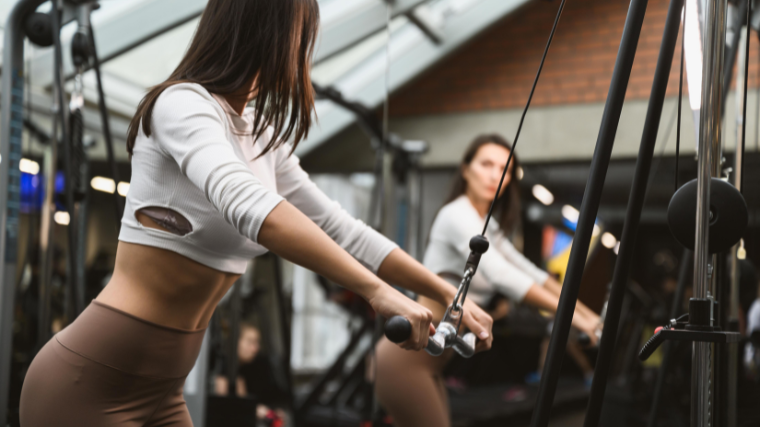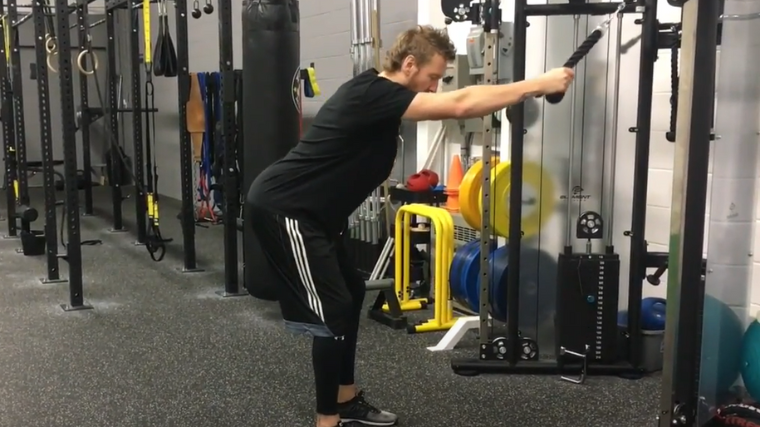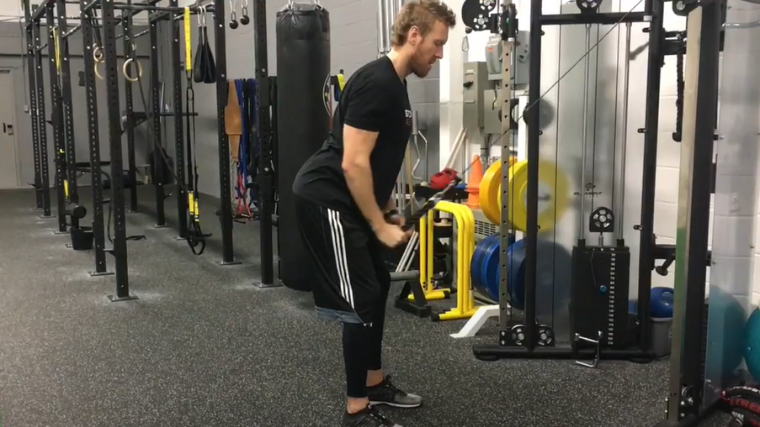Build Your Back Better With The Straight-Arm Pulldown
There is nothing that screams strength and power more than a thick, well-developed back. It is essential in almost all of the major lifts you perform in the gym, and the wider your back is, the smaller your waist looks. Not to mention the fact that a strong upper back is equally important for maintaining healthy shoulders.
While most back training programs focus on "meat and potatoes" movements like the row or pull-up, the straight-arm pulldown is an effective, underused isolation movement in your quest for a bigger, more chiseled back.

Isolation exercises can be extremely valuable when you’re looking to build a specific muscle group or rehabilitate an injury. While compound exercises should make up the majority of your training, there will always be a place for accessory work like the straight-arm pulldown.
- How to Do the Straight-Arm Pulldown
- Straight-Arm Pulldown Sets and Reps
- Common Straight-Arm Pulldown Mistakes
- Straight-Arm Pulldown Variations
- Straight-Arm Pulldown Alternatives
- Muscles Worked by the Straight-Arm Pulldown
- Benefits of the Straight-Arm Pulldown
- Who Should Do the Straight-Arm Pulldown
- Frequently Asked Questions
- How to Do the Straight-Arm Pulldown
- Straight-Arm Pulldown Sets and Reps
- Common Straight-Arm Pulldown Mistakes
- Straight-Arm Pulldown Variations
- Straight-Arm Pulldown Alternatives
- Muscles Worked by the Straight-Arm Pulldown
- Benefits of the Straight-Arm Pulldown
- Who Should Do the Straight-Arm Pulldown
- Pull It Together
- FAQs
How to Do the Straight-Arm Pulldown
The straight-arm pulldown is most often done from a standing position while using a straight bar or rope attachment in a cable pulley system.
Step 1 — Set Up

Attach the bar or rope to the top of the pulley system so you can achieve a full range of motion. Grab the attachment roughly shoulder-width apart and step back until tension is established. Lean your torso forward slightly until you feel a stretch in your lats.
Coach’s Tip: Try to keep your shoulders externally rotated by having the inside of your upper arm face your torso.
Step 2 — Pull Down

Keep a slight bend in your arms and sweep the bar down towards your body. Your arms should remain mostly straight. The attachment should make contact with (or adjacent to if you’re using a rope) your upper thighs.
Coach’s Tip: Focus on depressing your shoulders first and then bringing your arms down and back.
Step 3 — Reverse and Control

Reverse the motion and return the handle to the starting position while maintaining full control throughout the eccentric portion of the lift.
Coach’s Tip: Changing your torso angle may affect where you "feel" your lats working hardest.
Straight-Arm Pulldown Sets and Reps
While there may be more effective exercises for enhancing strength, the straight-arm pulldown serves as the perfect accessory movement to build your lats and increase overall training volume. Isolation exercises like the straight-arm pulldown are typically performed with higher repetitions and an emphasis on time under tension.
- To Build Muscle: Perform 2-4 sets of 10-20 repetitions with a moderate load and controlled tempo.
- To Warm-Up or Pre-Exhaust: Perform 1-2 sets of 10-15 repetitions with a lighter load to engage your lats.
Common Straight-Arm Pulldown Mistakes
The straight-arm pulldown is relatively simple and hard to screw up, but there’s still some room for error. If you’re going to utilize this lift in your quest for a bigger back, you might as well make sure you’re performing it optimally and in a way that aligns with your goals.
Going Too Heavy
You don’t need to push the intensity too high on the straight-arm pulldown. The whole point of accessory movements are to build a specific body part with a targeted focus. If you go too heavy, you may end up compensating and recruiting additional muscles to complete the movement. Save the heavy weights and maximum effort for your compound exercises.
Not Focusing On the Muscle
One of the main differences between training for strength versus hypertrophy is intent. When training for strength, you are trying to move a maximal load from point "A" to point "B." If you’re training for speed or power, you want to accelerate the weight as fast as you can.
When it comes to building muscle, you want to produce high levels of metabolic stress and stimulate as many muscle fibers as possible. With the straight-arm pulldown, it’s easy to let the triceps take over and reduce some of the tension on the lats, dramatically reducing the efficacy of the movement.
Going Too Light
The entire goal of training is to induce an adaptation. If you use the same exercise with the same weight for too long, your body will eventually grow too comfortable with it. Even though you don’t need to go too heavy with the straight-arm pulldown, the rules of progressive overload still apply.
In order to keep progressing with this movement, you’ll need to increase the weight, volume, or adjust the way you perform the repetition. Don’t slack off on your accessory movements just because they lack the glitz and glamor of a heavy barbell lift.
Straight-Arm Pulldown Variations
While you can never go wrong with the basics, a bit of novelty never hurts. By adjusting your grip placement, switching the attachment, or slightly altering the bar path, you can find many ways to challenge the traditional straight-arm pulldown.
Kayak Pulldown
As the name suggests, this exercise is a blend between a traditional straight-arm pulldown and a kayak row. The kayak portion of the movement allows you to increase the range of motion and really feel your lats working.
By alternating with the straight-arm pulldown, it’s the perfect pairing to create a powerful back pump and fry your lats.
Unilateral Straight-Arm Pulldown
Bilateral training has many benefits, but every program should feature a healthy dose of unilateral training as well. The unilateral, or single-arm, straight-arm pulldown is especially effective since you are able to achieve a greater range of motion compared to the bilateral version, which may have a beneficial effect on muscle growth.
While your non-dominant arm might be able to hide its weaknesses during bilateral lifts, the unilateral straight-arm pulldown will make sure to highlight — and correct — any imbalances.
Straight-Arm Pulldown Alternatives
There are plenty of other exercises that you can use to isolate and grow your back. The lying pullover and chest-supported pulldown both provide direct work for the lats and add a new stimulus for your body to adapt to.
Dumbbell Pullover
If you don’t have access to a cable tree, but still want to train your lats through an extension pattern, look no further. The lying dumbbell pullover is a fantastic free-weight choice for isolating your lats and training the biomechanical action of shoulder extension.
All forms of the pullover (you can use a dumbbell, a kettlebell, or even work with a medicine ball) provide a nice stretch for the lats and work the muscle through its full range of motion.
Chest-Supported Straight-Arm Pulldown
Chest-supported exercises eliminate technical cheating and often work well for those training around lower back pain or other injuries. By resting on the bench and taking your legs out of the equation, the chest-supported straight-arm pulldown will place all of the tension on your back and limit any help from additional body parts or extra momentum that may hamper your technique.
Muscles Worked by the Straight-Arm Pulldown
The straight-arm pulldown primarily emphasizes the latissimus dorsi (lats) and the teres minor muscle. Both of these muscles work to extend the arm, which is the main action in this exercise. Your triceps will get some indirect work as well, as they also assist with extension of the arm.
Latissimus Dorsi
Most people incorrectly assume that the lats are just that slab of muscle underneath your armpit, but they are actually the largest back muscle and span all the way down to the pelvis. The lats assist in adduction, internal rotation, and extension of the arm.
Even though it doesn’t have much to do with being jacked, the lats are also known as a respiratory accessory muscle and assist with your breathing patterns.
Teres Minor
The teres minor is one of four muscles that make up the rotator cuff. It is a small muscle that originates on the scapula and primarily works to externally rotate the shoulder. However, it also assists in adduction and extension of the arm.
Triceps
The pulldown (or pullover) is technically an isolation movement — the only joint that moves is the shoulder. That said, you’ll probably notice a bit of a triceps burn during your sets. This is due to the anatomical design of your triceps brachii.
The "long" head of your triceps is distinct from the other two in that it also crosses the shoulder joint in addition to the elbow. Therefore, it can provide a bit of assistance in pulling your upper arm down to your sides. Some triceps stimulation on the pulldown is perfectly normal.
Benefits of the Straight-Arm Pulldown
The straight-arm pulldown is a staple in any well-rounded program, whether the goal is to build muscle or prepare the shoulders for a heavy day of bench pressing. If you’re looking for a simple, joint-friendly exercise to grow your lats, this is it.
Isolates Your Lats
Truth be told, some people go too heavy on their main pulling exercises and get all sorts of "extra" help from the shoulders, biceps, and momentum itself. Because of this, the individual back muscles might not be getting the attention they deserve.
Hypertrophy requires metabolic stress, muscle fiber recruitment, and mechanical tension on the muscle itself. Training for strength is not the same as training for muscle gain. If you want to bring up lagging body parts or balance out asymmetries, you’ll find isolation exercises particularly effective when added to a larger, balanced training plan.
Serves As a Solid Warm-Up
A big bench press almost always requires a strong, developed back. The shoulder is the most mobile joint in the body, and your upper back will provide a solid foundation and the stability needed to press safely and effectively.
Keeping your lats engaged by pulling the bar to your chest, or thinking about bending the bar in half, will keep your form in check and boost your bench total. Use the straight-arm pulldown as a precursor to your bench press — your shoulders will thank you.
Who Should Do the Straight-Arm Pulldown
Regardless of your goals or training level, the straight-arm pulldown deserves a place in your training repertoire. The question is, for whom is it most applicable?
Bodybuilders
When preparing for a bodybuilding show, the posterior half of your physique often separates the winners from the rest of the pack. Bodybuilding is about blending size, definition, and symmetry into an aesthetically-pleasing package.
A wide, muscular back will accentuate your shoulder-to-waist ratio, or the coveted "v-taper". While bodybuilders still include plenty of compound lifts, you’ll often see bodybuilders lean on isolation movements like the straight-arm pulldown to sculpt and refine their bodies.
Strength Athletes
Strength athletes like powerlifters or Olympic lifters might not be as interested in aesthetics as bodybuilders, but joint health is a top priority if they want to be able to compete at their highest level. While compound lifts reign supreme for developing strength, it’s easy to hide imbalances and develop compensatory patterns over time.
As such, strength-focused trainees should choose their accessory work wisely and bring up their weak links with effective exercises like the straight-arm pulldown.
Recreational Lifters
If you’re lifting weights to build a little muscle, improve joint health, or reap the many, many benefits of resistance training, the straight-arm pulldown is the perfect exercise for you. It doesn’t require a lot of coaching or fancy equipment. Even if you don’t have a pulley system or cable station, there are still ways to access this pattern with a dumbbell or other type of equipment.
Pull It Together
Whether you’re an avid weightlifter, or a beginner just looking to shape up your physique, the straight-arm pulldown can help you strengthen and define your back. If you’re looking to keep your shoulders healthy, grow your wings, or fill out your T-shirts, you have no good reason to overlook the pulldown.
FAQs
Still have some questions about the straight-arm pulldown? These answers should help.
How often should I do the straight-arm pulldown?
If building muscle is your goal, training a body part 1 to 2 times per week is your best course of action. By utilizing the variations discussed above, you can easily work the straight-arm pulldown into your program twice per week. While it’s a great exercise to include on your back day, it can also be used as a warm-up on chest day.
How wide or narrow should my grip be?
This is a great question and will come down to the individual and their specific goals. The standard grip will be shoulder-width, but you can also use a wider grip to change the stimulus slightly.
Find a grip that doesn’t cause any discomfort and allows you to feel your lats working.
Can you do the straight-arm pulldown seated or kneeling?
Absolutely. The benefit of a chest-supported or kneeling position is the removal of any help from your legs. This limits the amount you can cheat when performing the exercise.
{"@context":"https://schema.org","@type":"FAQPage","mainEntity":[{"@type":"Question","name":"How often should I do the straight-arm pulldown?","acceptedAnswer":{"@type":"Answer","text":"
If building muscle is your goal, training a body part 1 to 2 times per week is your best course of action. By utilizing the variations discussed above, you can easily work the straight-arm pulldown into your program twice per week. While itu2019s a great exercise to include on your back day, it can also be used as a warm-up on chest day.
"}},{"@type":"Question","name":"How wide or narrow should my grip be?","acceptedAnswer":{"@type":"Answer","text":"
This is a great question and will come down to the individual and their specific goals. The standard grip will be shoulder-width, but you can also use a wider grip to change the stimulus slightly.
Find a grip that doesnu2019t cause any discomfort and allows you to feel your lats working.
"}},{"@type":"Question","name":"Can you do the straight-arm pulldown seated or kneeling?","acceptedAnswer":{"@type":"Answer","text":"
Absolutely. The benefit of a chest-supported or kneeling position is the removal of any help from your legs. This limits the amount you can cheat when performing the exercise.
"}}]}
Featured Image: ANRproduction / Shutterstock
Deja una respuesta

►Te puede interesar...